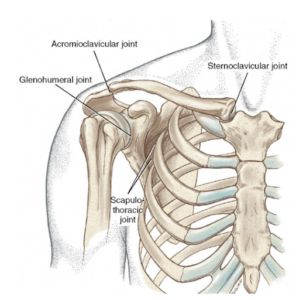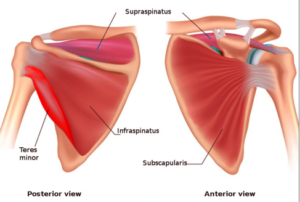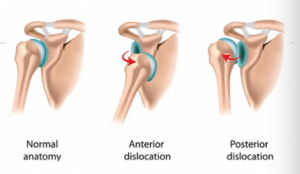Warming Up to Win: The Importance of Proper Shoulder Care to Decrease Risk of Injury
Shoulder Anatomy
The shoulder is one of the most freely moveable areas in the human body making it structurally and functionally intricate. Our shoulder complex is designed for mobility to move and position our hand through a large range of motion. It requires muscle forces for stability and consists of 4 joints that all need to be working properly to have fluid motion at the shoulder joint. Due to its anatomy and demands the shoulder is highly susceptible to dysfunction and injuries.

Shoulder Injuries in Sports
Shoulder injuries are common in sports especially those that involve overhead and throwing activities putting many athletes at risk of injury which could negatively impact their participation and performance.
- Rotator Cuff Tears: The rotator cuff is a group of 4 muscles that allow the shoulder to rotate while also providing stability to the shoulder. Repetitive stress or sudden trauma can cause a tear to one of the muscles resulting in pain, weakness, and restricted motion.
- SLAP Tears: The labrum is a ring of fibrocartilage surrounding the shoulder socket to increase the depth and provide enhanced stability of the shoulder. With repetitive overhead motion a tear to the superior labrum in an
 anterior to posterior direction can occur resulting in pain and subsequent instability.
anterior to posterior direction can occur resulting in pain and subsequent instability. - Shoulder Instability: Unwanted and excessive translation of the humeral head on the glenoid fossa causes alteration in comfort and/or function from overuse and microtrauma. It can lead to subluxation or dislocation of the shoulder especially in the anterior direction.
- Shoulder Impingement: The tendons of the rotator cuff get pinched between structures during overhead and throwing movements leading to inflammation, pain, and limited motion.
The Importance of a Proper Warm Up to Decrease Risk of Injury
The goals of a warm-up include increasing blood flow, improving joint mobility and tissue flexibility and activating the muscles in a balanced way. A randomized controlled trial of 16 youth baseball teams showed that a prevention program reduces the incidence of throwing injuries in the shoulder and elbow by 50% in youth baseball players while enhancing their pitching performance. A proper warm up should begin with dynamic stretching followed by light strengthening/muscle activation. At the conclusion of every workout, practice, and game static stretching of the shoulder joint should be performed to assist with muscle recovery and decrease soreness.
Some Suggested Shoulder Activation Exercises
Bilateral ER with Scapular Retraction
- Hold resistance band in both hands with palms facing the ceiling and elbows bent by your side to 90 degrees
- While keeping your elbows at your side slowly rotate forearms out to the side while pinching your shoulder blades down and together
- Hold the squeeze for 5 seconds then return to starting position and repeat

Standing Horizontal Abduction
- Hold resistance band in each hand with palms down and arms straight in front
- Pull arms apart until they are directly at your side then return to starting position and repeat

Lawnmower
- Stand in split stance with resistance band under back foot while holding in opposite hand
- Rotate trunk forward and down to reach towards the front foot
- Rotate up while bending the elbow

Standing IR 90-90 Position
- Stand with arm out to the side and bent to 90 degrees while holding a resistance band behind you at shoulder height
- Rotate arm forward without letting elbow drop and slowly return to starting position

Standing Row with 90-90 ER
- Hold end of resistance band and bend elbow to 90 degrees
- Lift arm out to the side at a 45-degree angle and rotate forearm
- Slowly reverse the movement and repeat

Standing Diagonal Pull Apart
- Hold ends of resistance band in each hand with arms at shoulder height
- Pull your arms diagonally in opposite directions then return to starting position
- Repeat while pulling arms in other diagonal direction

Push-Up Plus
- Begin in plank and perform a push-up
- At top of push-up lift upper back up towards the ceiling then lower back to neutral

Conclusion
While evidence does suggest that proper shoulder care is successful in decreasing the occurrence of shoulder injuries in throwing and overhead athletes, it is important to note that injuries are multifactorial and therefore not 100% preventable. However, incorporating stretching and light strengthening exercises into your typical routine can set you up for healthy shoulders throughout your athletic career and life. Give some of these exercises a try but always remember to listen to your body and incorporate some rest days to prevent overuse injuries. For any specific questions or specific shoulder injuries please contact us to set up an appointment with one of our physical therapists.
References:
- Miniato MA. Anatomy, shoulder and upper limb, shoulder. StatPearls [Internet]. July 24, 2023. Accessed June 24, 2025. https://www.ncbi.nlm.nih.gov/books/NBK536933/.
- Oak SR, Klein B, Verma NN, et al. Rehabilitation and Return to Play of the Athlete after an Upper Extremity Injury. Arthroscopy, Sports Medicine, and Rehabilitation. 2022;4(1):e163-e173. doi:10.1016/j.asmr.2021.09.033. PMID:35141548
- May T, Garmel GM. Rotator Cuff Injury. [Updated 2023 Jun 26]. In: StatPearls [Internet]. Treasure Island (FL): StatPearls Publishing; 2025 Jan-. Available from: https://www.ncbi.nlm.nih.gov/books/NBK547664/
- Cohen SB, Matthews JR. SLAP Tears. Video Journal of Sports Medicine. 2021;1(3). doi:10.1177/26350254211000754
- Arguello AM, Till SE, Reinholz AK, Okoroha KR, Barlow JD, Camp CL. Managing Shoulder Instability in the Overhead Athlete. Curr Rev Musculoskelet Med. 2022;15(6):552-560. doi:10.1007/s12178-022-09796-x
- Wilk KE, Meister K, Andrews JR. Current concepts in the rehabilitation of the overhead throwing athlete. Am J Sports Med. 2002;30(1):136-151. doi:10.1177/03635465020300011201
- Sakata J, Nakamura E, Suzuki T, et al. Throwing Injuries in Youth Baseball Players: Can a Prevention Program Help? A Randomized Controlled Trial. Am J Sports Med. 2019;47(11):2709-2716. doi:10.1177/0363546519861378
- Mullaney M, Nicholas S, Tyler T, Fukunaga T, McHugh M. Evidence Based Arm Care: The Throwers 10 Revisited. Int J Sports Phys Ther. 2021;16(6):1379-1386. Published 2021 Dec 1. doi:10.26603/001c.29900
*All exercise images taken from MedBridge
